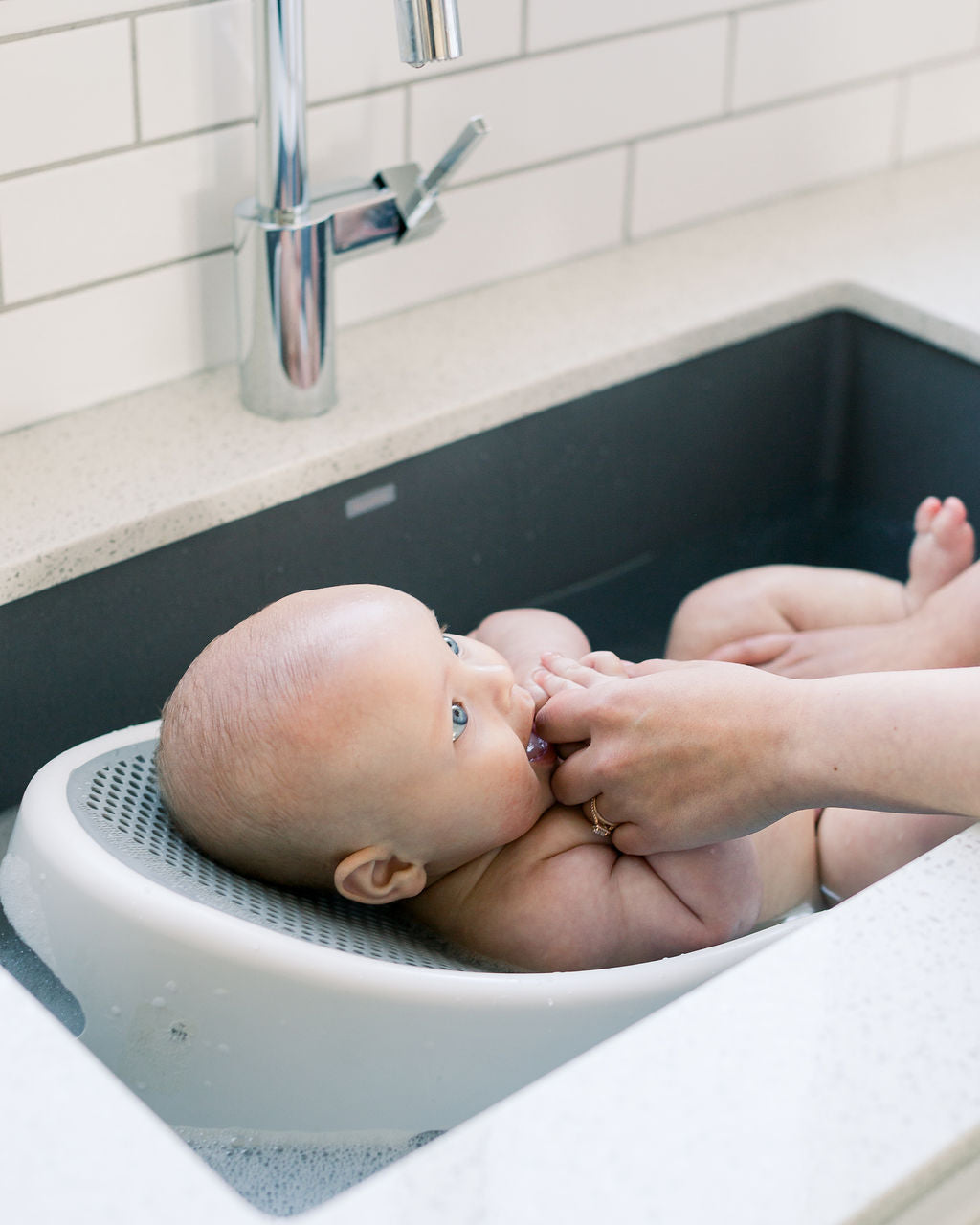
A Step-By-Step Guide to Bathing Your Newborn Baby
Share
So you’ve brought your newborn home. Congratulations! A bit of time has passed, their umbilical cord stump has fallen off and you’re gearing up to give your little one their very first bath at home. Giving your baby a bath can be intimidating, but with a few simple steps, it can be easier to handle. Here’s what you need to know:

To make bathing your baby as smooth as possible, get these essentials ready before bathing your little one
- Set out your baby’s clothes, diaper, diaper cream and lotion (if you plan on using some) on their change table (or wherever you are planning to dress them after their bath). That way, you can quickly clothe without having to pause to gather these items.
- Place wash cloths, a towel, a rinse cup, bath wash/shampoo beside the bath/sink you plan to use.
- If you are using our wearable, hands-free towel, make sure to snap it on before you give your baby a bath.
- Heat up the bathroom so your baby doesn’t get cold. Either crank up the heat in the room or turn on the hot shower to create steam. This will keep the room warm and toasty.
- Fill the sink/bath with a shallow amount of lukewarm water. Usually 2 inches of water is more than enough. The temperature of the water should ideally be between 37 – 38 degrees Celsius. You can use a bath thermometer to test the temperature. If you don’t have one, use your inner wrist to test the water.
- We recommend using a sink to bathe your baby or a baby bathtub with a stand or one that can rest on a secure surface that is waist level. That way, you don’t have to uncomfortably bend down into a regular sized tub while bathing your baby. If you use a sink, use padding such as towels or blankets to make the surface of the sink softer for your baby. Alternatively, you can purchase a sink insert for babies.
Once all your essentials are ready, you are now ready to bathe your baby
- Undress your baby in a warm room and bring them into the bathroom. Try to do this quickly since babies tend to get colder much quicker than adults (since their skin is so thin) and you want to avoid an irritable baby before beginning their bath.
- Place your baby’s body into the tub/sink using both hands. Use one hand to support their head and the other hand to support their body as you gently place them into the water, feet first. Make sure their head and neck are always above the water.
- To keep them warm, you can wet a muslin cloth/blanket in lukewarm water and place it on their chest.
- Use a washcloth to wash your baby. Start with their face. For this part, use only warm water without soap to avoid getting soap in your baby’s eyes. Make sure to gently wipe around your baby’s ears, their neck folds and eyes.
- If you are washing their scalp (you only need to do this once to twice a week), use a very small amount of mild baby soap on your washcloth. Cup one hand across your baby's forehead to prevent soap from going into their eyes as you rinse the soap from their scalp using your washcloth or a rinse cup.
- Move top down and wash their other body parts using a small amount of mild baby soap. Make sure to wash in between the folds of their skin, under their arms and legs and their genital areas
- Use a rinse cup or a washcloth to rinse the soap off their body.
Always remember to keep both hands on your baby and supervise them at all times. Babies can drown even in shallow amount of water.
Now you are ready to remove them from the bath
- When removing your baby from the bath, use both of your hands as babies can be extremely slippery and wiggly. You want to ensure they don't slip or fall. To avoid this, we recommend using our wearable, hands free towel which allows you to safely place the baby on your chest and wrap them up quickly. Your towel should have a hood to prevent your baby from getting cold and loosing too much body heat.
- Pat them dry with the towel, and make sure to dry any folds/creases in their skin, including under their neck.
- Move them to their room/change table, place a diaper on them, and quickly dress them to keep them toasty and warm.
Tada! You’ve gotten through your first of many more baby baths to come!
The main takeaway here is to make sure your baby is always safe during bath time. This means they should be always supervised, and both your hands should be on them to ensure no injuries occur. Your baby may cry and get irritable in the bath – don’t worry! This is completely normal and may require some troubleshooting over time. You can try to adjust the temperature of the water, the temperature of the room, or try to give your baby a bath during a different part of the day when they aren’t likely to be tired or sleepy.
